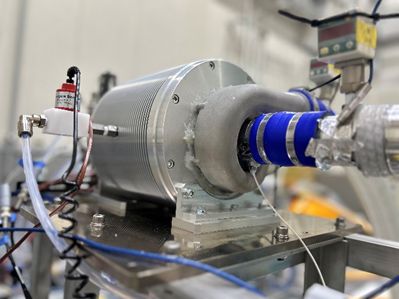IHI’s Vacuum Pump, Gas-Bearing Technology Tackles Fuel Efficiency
IHI Corp. is researching aircraft electrification and hydrogen fuel technologies and developing a vacuum pump to enhance operational efficiency.
Last week, IHI Corp. and Akita University announced the successful development and testing of its vacuum pump and gas-bearing motor technology at the Joint Research Center for Electric Architecture. The duo conducted hybrid laminar flow-control (HLFC) simulations, concluding that the technology was effective in:
- Reducing friction and degradation
- Maintaining stable performance during low-density cruising altitudes
- Minimizing maintenance work
- Delivering reliability in harsh environments
According to a representative from IHI, testing was conducted with a proprietary ultra-high-speed electric rotary machine equipped with gas bearings. Next, the company will address the challenges of HLFC system engineering, avoiding an impact on fuel efficiency due to installation-related weight increases. Akita University provided the testing site and supported the evaluation and measurements.
The system is designed to address the challenges historically faced by HLFC technologies, which were initially developed in the 1930s. IHI’s compact, lightweight pump reduces fuel efficiency, thus cutting CO2 emissions generated during flight. “This technology for reducing air resistance has been advocated in the industry for nearly a century, but there had been no progress in developing a compact vacuum pump necessary for its implementation,” said an IHI representative. “This is why the challenge was taken on this time.”
HLFC technology actively controls airflow through a powered system, suctioning air through minuscule holes on the wing’s leading-edge surface to minimize crossflow instability. At the wing’s rear, it creates a beneficial pressure gradient to replicate natural laminar flow. The combination of these control methods optimizes aerodynamic performance and efficiency.
Hydrogen recirculation system; image credit: IHI Corp.

“The key point of this development lies in the successful creation of a vacuum pump that achieves both "compact and lightweight" design and "high airflow capacity," which have traditionally been difficult to reconcile in low-pressure environments,” said IHI’s representative. “The success of this trial hinges on IHI's proprietary gas-bearing technology, which has been continuously pursued and is indispensable for realizing this device.
IHI also plans to address aircraft fuel efficiency, CO2 emissions, and additional operational improvements by integrating other technologies, such as aircraft electrification and hydrogen fueling systems.
IHI on Biomass Power
In February 2024, Turbomachinery International spoke with Chris Quijano, IHI Power Services’ Director of Operations, about the state of the biomass industry, the challenges of working with biomass, and where the industry is headed.
Quijano breaks down the woody biomass industry in California: “California has the majority of the woody biomass power plants in the nation; currently, there are 23 operational biomass power plants in the state. This industry has been around since the 80s, and there are three different types of woody biomass that we use at the plants. Urban material is your green garbage cans and branches that tree services remove. Agricultural material comes from the orchards in the Central Valley—those orchards only produce fruit for so many years, and they have to knock them down. That material can be used at biomass plants to make energy. And then there is forest material—when I say forest we aren't going out there and cutting down healthy trees just to make power. This is a low-value material that has no other real use.”